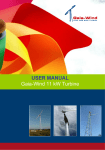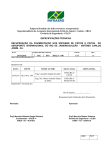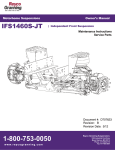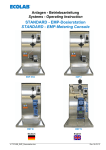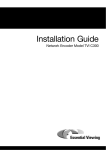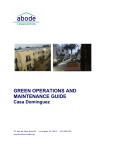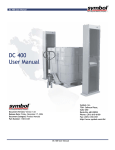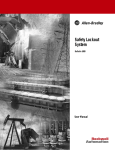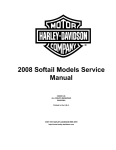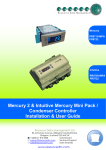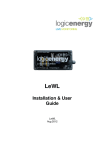Download Gaia-Wind 11 kW Turbine
Transcript
SERVICE MANUAL Gaia-Wind 11 kW Turbine Your own Wind Turbine Copyright © 2008 Gaia-Wind Ltd. 1 Ainslie Road Hillington Park Glasgow G52 4RU United Kingdom Tel: +44 (0) 845 871 4242 E: [email protected] Reference number: GW-UK-20-0808 Service Manual Document revised: August 2008 All illustrations and photographs Copyright © Gaia-Wind. No part of this manual may be transmitted into any form by any means without permission from Gaia-Wind. The information given in this user manual is believed to be accurate and reliable at time of printing. All specifications are subject to change without prior notice 2 Table of Contents Health and Safety Information 6 Tools and Equipment Requirements 9 Tool Requirements 9 Equipment 9 Recommended Spare Parts 10 Introduction 12 Overview 12 Servicing Intervals Three Month Service Annual Service 12 12 13 Servicing Checklist 13 Servicing Log 13 Necessary Controller Procedures 14 Acquiring Access Rights & Active Status 14 Releasing Active Status & Access Rights 16 Resetting Error Menu 17 Accessing System Production 19 1. Functionality Test 21 Start the Turbine 21 Record Wind Speed and Power Output 21 Turbine Observations 22 Manual Stop Test 22 Emergency Stop Test 23 2. Sensor Inspection 24 Cable Twist Sensor 24 RPM Sensors 25 Anemometer 26 Vibration Sensor 27 Brake Worn Sensor 27 3. Visual Inspection 28 Teeter-Hub 28 3 Blade 28 Nacelle 29 Bearing 29 Cables s 29 4. Brake Inspection & Functionality Test 31 4.1 Calibrate Brake 31 Change Operational Parameters 32 Secure the Rotor 33 Brake On/Off 33 Check Brake Configuration 34 Brake Adjustment 35 Brake Caliper Inspection 35 Brake Sensor Positioning 36 Recheck Calibration 37 Release Rotor 37 Reset Operational Parameters 37 4.2 Tip Brake Test 38 Service Mode and Parameter Change 38 Deploy Tip Brakes 39 Reset Tip-Brakes 39 Reset Parameter Settings 40 Deactivate Service Mode 40 5. Greasing and Oil Change 41 Grease Main Bearing 41 Grease Yaw Bearing 41 5.2 Oil Change 42 Removing Oil Method 1 Method 2 42 42 43 Applying New Oil Method 1 Method 2 44 44 44 6. Nacelle Level 45 45 45 Lattice Tower Tubular Tower 4 7. Bolt Inspection 46 7.1 Nacelle 46 7.2 Hub Assembly 51 Hub Brackets and Rubber Buffer 51 Blade Spring Brackets 51 7.3 Tower Bolts 52 Tubular Tower 52 Lattice Tower 53 Ladder Sections 53 Cable Guides (Lattice Tower Only) 54 Cable Twist Sensor 55 Electrical Connections 55 8. Untwisting of Cables 56 Disconnect Power and Signals Cables 56 Untwist Cables 57 Reattach Cables 57 9. Levelling Adjustments 58 Tubular Tower 58 Lattice Tower 59 10. Tubular Tower Grouting Procedure 60 Conclude Servicing 68 Service Checklist 68 Service Log 68 Restart the Turbine 69 Servicing Checklist 70 Gaia-Wind Servicing Log 81 Appendix A – Tubular Tower Levelling Chart 82 Appendix B – Lattice Tower Levelling Chart 90 Appendix C – Tip Brake Spring Settings 91 5 Health and Safety Information Ensure that these instructions are read thoroughly and understood. It is essential that they are retained, along with the remainder of the manual, as they contain important safety information that must be adhered to. • It is compulsory that all personnel involved in the construction and/or maintenance of the turbine wear appropriate personal protective equipment (PPE) at all times; including, but not limited to, a high visibility jacket, hard hat, and safety boots Gloves are recommended to be worn to improve grip on the ladder rungs and protect hands; Standard safety boots, with steel reinforced toes to approved standards and non-slip soles; a plastic helmet to approved standard with a chin strap to keep the helmet in place. • Do not attempt to ascend the turbine tower and/or work on the turbine should wind speeds exceed a value of 12 metres per second • It is essential to ensure that all ladders, safety lines, and working baskets are kept in clean working order at all times • Only one person is permitted to stand inside of the working basket at any one time 6 • Before ascending the tower, for any reason, the turbine must be stopped and the main switch set to the off position • The nacelle must be locked with an anchor bolt before any work is performed on, or near to, any rotating or moving parts • It should be ensured that during installation and maintenance that there is always more than one person present at all times, and that work does not continue in the event of adverse weather conditions which could reduce safety. • All workers must be fully briefed on the sequence of operations before commencement. This is to include the identification of danger areas that must not be occupied during the servicing procedures. • All personnel working at height must work according to the requirements of the relevant statutory provisions, including the use of PPE for working at heights. All personnel must have been trained by a recognised body to work at heights, ideally a BWEA Working at Height Training Course. • Existing site factors, e.g. overhead or underground electric cables should be identified and an exclusion zone set • During installation and maintenance procedures which require climbing of the tower, an appropriate safety harness for working at heights must be worn at all times. 7 Double lanyards with shock absorber should be used when climbing the ladder. A work positioning device must be used when any work is required which could take away the use of the climbers hands as points of attachment to the tower. • Turbine electrical works are to be undertaken by experienced, competent, and authorised personnel who are fully familiar with the standard working practises within the electrical industry, and who are acquainted with the maximum voltages present on the system being installed. • Temporary signs, notices, and barriers should be erected if required. If road closure is required this should be put in place well in advance with the local authority. • Structural and mechanical installation must be actively managed and supervised by a suitably experienced and competent person. • The turbine’s electrical supply must be isolated for all works on the electrical system. 8 Tools and Equipment Requirements Tool Requirements Torque Wrench Bolt Dia Span Moment M 27 NV 41 700-1100 Nm M 20 NV 30 425 Nm M 16 NV 24 210 Nm M 14 NV 22 140 Nm M 12 NV 18 Nm M 10 NV Spanners M10, M12, M17(x2), M22 (x2), M24 (x2) M30, M41 Allen Key M6 Screw Drivers Various Spirit Level Appropriately calibrated, digital spirit level Anchor Bolt M16 x 120 (for yaw locking) Head cut-short (brake caliper adjustment) Equipment Mobile Crane (Cherry Picker) For access to tower and nacelle, must be capable of carrying two people + tools Safety Harness To approved standards Safety Helmet 9 Zinc Based Aerosol 1 Can Degreasing Solution 1 Can Bag of Rags Gearbox Oil – LE 1606 (annual service only) Main Rotor + Yaw Bearing Grease – LE 3751 Almaguard ®, vari-purpose lubricant (annual service only) 11.4 ltrs. For complete oil change 1 Tube Recommended Spare Parts Number Rubber Bushings 2 Rotor Spring 4 Nylon Bush (Spring) 4 M12 Nyloc Nuts (Basket) 4 Locking Pin (rotor rod & spring bracket) 4 Brake Pads 1 Set Sensors 1 Complete set Lattice Tower M 27 x 140 Bolt 2 M 27 Nut 2 M 27 Washer 4 M 14 x 30 Set Screw 8 10 M 14 Nuts 8 1 Set of Shims Tubular Tower M 27 Nut 4 M 27 Bushing 4 M 20 x 80 Bolt 4 M 20 Bolt 4 M 20 Washer 4 M 16 x 80 Bolt 4 M 16 Nut 4 M 16 Washer 4 M 14 x 30 Screw Set 4 M 14 Nuts 4 11 Introduction Overview This document provides information and instructions for performing servicing on the Gaia-Wind 11kW turbine. The details provided herein present the conventional sequence of servicing checks including full inspections of the turbine controls, sensors, brakes, oil and grease, and bolt connections. Please take careful note of the health and safety instructions summarised on the opening pages of this manual. In addition there is a degree of safety procedures specific to individual tasks that must be adhered to - these are detailed in the relevant sections of this manual. Servicing Intervals Three Month Service It is required that a full inspection of the turbine is completed three months after the installation of the turbine. All of the tests within this manual should be performed during this service with the exception of the greasing and oil changes outlined in section 5. 12 Annual Service It is compulsory a full inspection and servicing of the turbine is performed at least once a year. All of the tests and checks detailed in this manual should be performed during the annual service with the exception of the tubular tower grouting outlined in section 9, which applies specifically to the three month service after installation. Servicing Checklist A Gaia-Wind servicing checklist accompanies this document. The tests in the checklist correspond with the prescribed testing procedures detailed within this manual. It is compulsory that the checklist is completed throughout the course of the servicing. Upon completion the checklist should be retained and a copy sent to Gaia-Wind. Servicing Log Each turbine should have a servicing log located on the inside of the controller. The log must be completed after each service by the servicing personnel. This includes details of the parts replaced and oil changes. A spare copy of this log is included as an attachment to this manual. 13 Necessary Controller Procedures For many of the procedures outlined, it is required that access rights and active status of the turbine controller are obtained. This can be achieved by following the steps outlined below. It is important that prior to leaving the turbine, that the access rights and active status are disabled. Therefore the following procedure should be followed upon completion of using the operating panel. Acquiring Access Rights & Active Status Step 1 Ensure that the operating panel is displaying the Start Menu. Step 2 Scroll down to the menu until the cursor line indicates Scroll down “Access Rights” Press enter on the keypad. Enter Step 3 The screen display will change (right). Enter the default user code: 456, using the numbers on the operating panel, and confirm by pressing enter. 14 Enter The display will return to the start menu, with Accessrights 99. Step 4 Navigate the start menu down until the cursor indicates, Scroll down “Request active-stat” Enter Press enter on the keypad Step 5 Enter the user ID: 1 and Confirm by pressing enter on the keypad The screen will revert back to the start access menu with both rights and active status. Step 6 Ensure that the LED labelled ‘Active’ on the top right hand side of the keypad is illuminated. This confirms that active status has been granted. 15 Enter Releasing Active Status & Access Rights Step 1 Ensure that the operating panel display shows the Start Menu. Step 2 Navigate down the until start menu the cursor indicates, “Release activestat” Enter Press enter on the keypad The display remains on the start menu Step 3 Navigate the start menu to the line “Access Rights”. Press enter on the keypad two times. Step 4 Enter The display will revert to the original start menu. You are now logged out of the turbine. 16 Additionally, the turbine operating panel is used to reset error messages. Error messages will occur during the service as the turbine controls are tested. It is required that these errors are reset after they appear. Resetting Error Menu Step 1 Ensure that the Start Menu is displayed on the keypad. If you have not done so, obtain Access Rights and Active Status. See section 5.2.1 for details Step 2 Scroll down to the menu line until the cursor is on the fourth Scroll down line “Status”. Enter Press enter on the keypad. Step 3 The screen displays the recent active errors. N.B. if no Scroll down information can be seen then there are no active errors. Scroll up Navigate through the error list using the cursor arrows. 17 Step 4 In the error menu press the ‘reset’ button on the keypad. Reset The error messages will be erased. If the error messages are not erased, the error has not been corrected. Step 5 Press the escape button to Escape return to the main menu. Step 6 The turbine will start automatically within 60 seconds subject to availability of wind. Alternatively, the turbine can be started immediately by pressing the start button. 18 Start The servicing checklist and service log require the total turbine power production to be detailed. By following the procedure below the total system production is displayed on the operating panel display. Accessing System Production Step 1 Toggle through the menus using the cursor directions buttons until the heading displays ‘Status’. Press enter on the Menu Line Enter ‘System’. The system submenu will appear on the screen. Step 2 Navigate to the submenu line, ‘prod./consump.’, and press Scroll Down enter. Enter 19 Step 3 The display should give a selection of time frames over which to view data. With the cursor on total, press Enter enter. Step 4 The final screen shows the production data. The important information here is the top line, the energy produced by the turbine. Step 5 To return to the previous menu Return to Submenu press escape. To return to the Status menu, hold control and escape. 20 Return to Status Menu 1. Functionality Test Start the Turbine If the turbine is not already running attempt to manually start the turbine by pressing the start button on the operating panel. If wind speeds are low the turbine will utilise pulses from the ‘softstarter’. This will be evident as pulses are accompanied by a brief noise and a negative power output. If excessive pulses are required, and the turbine has not cut-in, then the controller should display, ‘Motor start error’ – most likely for wind speeds below 3m/s. Should this occur reset the error and attempt to start the turbine when wind conditions improve. Record Wind Speed and Power Output Record the wind speed and power output from the turbine. This can be read directly from the Start Menu on the operating panel, e.g.(right) Power = 4.2 kW and Wind = 7.1 m/s If possible, note the power output at a range of wind-speeds. Enter this data to the section 1 of the servicing checklist. 21 Turbine Observations Allow the turbine to run for several minutes and observe; Are there any audible abnormal noises? Describe any noises in the servicing checklist Is there any visible shaking in the tower? Detail any shaking in the servicing checklist Is the turbine oriented with the rotor in the downwind direction? Detail observations in the servicing checklist If the turbine does not appear to be following the wind direction then pay close attention to section 6 of this document. Manual Stop Test The turbine braking time should be inspected in both high and low wind conditions. With the turbine running, press the Stop button in the operating panel. This will activate the turbine mechanical brake. Count the time taken for the turbine rotor to come to a complete stop from the moment the stop button is pressed. 22 The turbine should stop within 10 seconds, and a “Manual stop” error will appear on the operating panel display. Note the time taken and any observations on the servicing checklist. Attempt to perform this procedure in both low (<4 m/s) and high (>8? m/s) wind speeds. If it is detected that it requires more than 10 seconds to stop the turbine, pay close attention to section 4 of this manual. Reset the ‘Manual stop’ error message on the controller before continuing. Emergency Stop Test Test the turbine emergency stop procedure by pressing the emergency stop button on the side of the controller cabinet whilst the turbine is running. Record the wind speed and the time taken for the turbine rotor to come to a complete stop in the servicing checklist. Ensure that the turbine stops within 10 seconds and that an “Emergency stop” error is recorded on the operating panel. Upon completion of the test draw-back the emergency stop button, and reset the error. 23 2. Sensor Inspection It is required that all of the turbine sensors are inspected during the annual service. To correctly execute the following inspection of the turbine sensors two persons are required – one to manually stimulate the sensor and the other recording results and resetting errors from the operating panel. Cable Twist Sensor The cable twist sensor is mounted to a steel tab located at the bottom of the tower. This consists of a sensor unit and guide arm, with a circular ring through which the turbine output cables are attached. For the tubular tower, the cable twist sensor is accessible through the service hatch in the bottom tower section. With the turbine running – raise the sensor guide arm and hold. After a period of 1 minute the turbine should automatically shutdown. 24 A “Cable Twist” error message should appear on the operating keypad. Note the results on the servicing checklist. Reset the error before continuing. RPM Sensors The turbine has two separate RPM sensors – a low speed sensor located on the brake disc, and a high speed sensor on the generator. Both low and high speed sensors can be inspected by observing the readings from the turbine controller. These are located on the second line of the start menu, to the right of the wind speed value. During normal operation the reading should be approximately 56/1005. 25 Anemometer The anemometer is located on the upwind side of the turbine and records the wind speeds at the turbine hub height. The wind speed reading from the anemometer is located on the second line of the start menu on the turbine controller, displayed in m/s. Observe the reading from the anemometer, and ensure that; • The reading appears appropriate for the given turbine power output • The reading is steady, with no abrupt changes Note any observations in the servicing checklist. The following sets of inspections are to be performed from the working basket. demands the climbing of the tower. This Please see the safety instructions outlined on the opening pages for requirements. 26 Vibration Sensor The vibration sensor is located in front of the gearbox, above the main shaft. Stimulate the sensor by oscillating the top from side to side. Ensure that the error is recorded as on the operating panel screen as “Vibration”. Note the results in the servicing checklist and reset the error before continuing, Brake Worn Sensor The brake worn sensor is in the form of a roller located beyond the brake lever. In the event of wear on the brake pads, the brake lever will contact the roller, activating the sensor. Brake Worn Sensor Manually rotate the sensor. Ensure that a “Brake worn” error message is displayed on the turbine operating panel, and note into the servicing checklist. Reset the error before continuing. 27 3. Visual Inspection From a suitable working platform perform a brief visual inspection of the turbine copmponents listed below. Any excessive wear, visual damage, or corrosion should be noted on the servicing checklist. Teeter-Hub Perform a visual inspection of the teeter-hub assembly, particularly springs, the nylon hub bushings and rubber buffers. Note any wear or damage in the servicing checklist. ` Hub spring Blade Perform a brief inspection of the turbine blade. Note any observations in the servicing checklist. 28 Nylon Bushing Rubber Buffer Nacelle Visually Inspect all mountings and bushings within the nacelle, for wear or corrosion and check all fastenings for tightness. Note into the servicing checklist. Main Bearing Inspect the turbine main bearing, on the low speed drive at the outside of the machine frame. Inspect for any visible leaking of grease, corrosion, or wear. Note any observations in the servicing checklist. Cables s First stop the turbine, isolate the supply to the controller and turbine and wait 5 minutes before making the following checks which should be performed only by suitably qualified personnel. Inspect the external condition of all cables and the tightness of all high voltage electrical terminals inside and outside of the nacelle. 29 Follow the table in the servicing checklist, noting condition of cables and noting any loose connections and how many turns were required to retighten. 30 4. Brake Inspection & Functionality Test 4.1 Calibrate Brake The brake caliper should be set as shown in the schematic below. This shows the dimensions in the “brake off” position - an electromagnet is holding the spring back at a compressed length of 90 mm, and the brake disc is free to rotate. When there is a loss of grid or the stop button is activated, the current to the electromagnet is cut and the spring expands forward applying force to onto the brake caliper which in turn applies a force onto the brake disk via the braks pads sufficient to Figure 4A: Brake Schematic stop the turbine rotor. In order to inspect the calibration of the brakes it is required to alternate between the “brake on” and “brake off” position. This requires the turbine to be connected to the electrical grid supply. Therefore, in order to prevent the turbine motor starting the turbine parameters must be changed, and the rotor secured before commencing. Only carry out this procedure in light winds (<8 m/s). 31 To correctly execute the inspection and calibration of the braking system two persons are required – one operating from the working basket, the other on the ground using the turbine controller. Change Operational Parameters Ensure that full access rights and active status has been acquired. On the turbine operating panel toggle to the parameter menu using the keypad and select the “operation control” submenu Press enter on the line “Startwind”. Enter the maximum value of 35 m/s (thirty-five). This will ensure that the turbine will not attempt to cut-in using the soft starter. Remaining on the “operational control” submenu scroll down to the line “wing parking”. Press enter and change the value from ON to OFF. This will ensure that the turbine does not attempt to park the blades. 32 Secure the Rotor From inside of the working basket the rotor must be secured from rotation by tying a suitably rated canvas strap between the brake disc and the machine frame. The strap should have a safe working limit of at least 1000 kg. The strap should be affixed to the two holes located on the brake disc, and both sides of the machine frame. The strap should be tight and secure and prevent the shaft from rotating in either direction. Only once the rotation of the rotor has been secured should the remainder of the inspection continue. Brake On/Off Ensure that all stop switches and isolators are released. The personnel on the ground should start the turbine by pressing the Start button on the operating panel. This action will cause the spindle motor to extend bringing the electro magnet in contact with the magnet anchor. The spindle motor then retracts, releasing the brake. 33 The controller keypad should indicate that the brake is released. By pressing the stop button the magnet is de-energised enabling the spring to actuate the brake. If the operating panel display indicates that there is an error – reset and attempt to start the turbine again. Check Brake Configuration When the turbine is started by the controller the brake should move back to the “brake off” position before being secured in place with a retaining magnet. Whilst in this position the distance between the retaining magnet housing and the end of the spring holder should be measured – shown as position 2 and 3 in the diagram opposite respectively. Note this distance in the turbine servicing checklist. The critical dimension for this distance is 90mm – if the measurement above is not consistent with this dimension then the brake must be adjusted by following the instructions below. 34 Brake Adjustment If required adjust the brake setup using the following procedure; 1. Loosen the tightening spring nut (posn. 1.235) 2. Rotate the spring holder (posn. 48.0) – the spring holder has an internal nut welded to its inside face 3. Rotate the spring holder until the 90 mm critical dimension is achieved 4. Secure the tightening nut back against the spring holder 5. Measure again to ensure that the critical 90 mm distance has been maintained Brake Caliper Inspection Set the brake in the “brake off” position. Visually inspect the brake caliper and brake pads, and check for any visible wear or damage. Inspect the gap between the brake pads and the brake disc. 35 The pads should be close to the disc but without touching with even spacing on both sides If required the brake pads can be adjusted using the grub screws on either side of the calliper arms, using a shortened 5 mm allen key. Grub Screw Brake Sensor Positioning The person in the working basket should ensure that all tools are removed and his/her hands are clear from the nacelle. From the ground the Stop button should be pressed on the operating panel. The brake will move to the “brake on” position. Measure the distance between the wheel of the brake worn sensor and the end of the brake assembly. This distance should be approximately 10 – 12 mm. Record this information in the servicing checklist. 36 If an adjustment is required this should be made by adjusting the position of the sensor accordingly. Recheck Calibration Recheck all of the critical dimensions of the brake. This is necessary as even slight adjustments on the brake pads can produce large changes in the positioning of the lever arm. This will require the turbine to be in the “brake off” mode once more. From the operating panel on the ground, errors should be reset and the start button pressed. Recheck all of the critical dimensions in the three steps above, and adjust accordingly if required. Release Rotor From the turbine operating panel the Stop button must be pressed, and hence the turbine in the “brake on” position. Remove the ratchet straps from the brake disc Reset Operational Parameters Repeat the first step of the brake inspection procedure setting the control parameters back to their original settings. Start Wind: 3.5 m/s Wing Parking: On 37 4.2 Tip Brake Test The following procedure should be performed to test the turbine tip brakes. This test is reliant upon wind conditions in the range of 4-6 m/s. This procedure is performed with the turbine rotor running at full speed. No personnel should be inside of the working basket or ascending/descending the tower during the test. Personnel not involved in the test should stand clear of the turbine. Service Mode and Parameter Change Navigate to the service menu on the operating panel. Change Service Mode to ON Change Running Away from 0 to 1 Navigate the operating panel to the parameter menu. On the RPM control submenu change parameters to the following values; WT Version 50Hz (UK, DK etc.) 60Hz (US etc.) Max. Rotor: From 62 to 68 From 66 to 75 Max. Generator: From 1116 to 1300 From 1292 to 1500 38 On the brake control menu change; WT Version 50Hz (UK, DK etc.) 60Hz (UK, DK etc.) Max. Wheeling: From 1120 to 1300 From 1320 to 1500 Deploy Tip Brakes Start the turbine from the operating panel. By setting the turbine to “run away” the rotor will speed up until the tip brakes deploy. However the turbine may brake normally – if so it is required that the operational parameters of the turbine are altered. Note the wind speed and RPM at which the tip-brakes deploy and enter this onto the servicing checklist. Reset Tip-Brakes Reset by rotating the blades back into their original position using appropriate working platform or tools to do so. 39 Reset Parameter Settings Return to the parameter menu and reset all values to their original settings. On the RPM control submenu change the values; On the RPM control submenu change parameters to the following values; WT Version 50Hz (UK, DK etc.) 60Hz (US etc.) Max. Rotor: From 68 back to 62 From 75 to 66 Max. Generator: From 1300 back to 1116 From 1500 back to 1292 On the brake control submenu change; WT Version 50Hz (UK, DK etc.) 60Hz (UK, DK etc.) Max. Wheeling: From 1300 back to 1120 From 1500 back to 1320 Deactivate Service Mode Navigate to the service menu on the operating panel. Change Service Mode to OFF Change Running Away to 0 Reset any errors in the turbine. 40 5. Greasing and Oil Change Greasing and oil changes form a component of the annual service of the turbine only, and are not required for the three month service. 5.1 Grease Bearings Grease Main Bearing Remove all excess grease from the outside of the main bearing using a rag. Using a grease gun apply the LE3751 grease through the nipple on the top of the main bearing. Continue to apply grease until it is detected that excess grease is excreted through the outside of the bearing. Remove any residual grease using the rag. Grease Yaw Bearing Remove all excess grease from the outside of the yaw bearing using rag. There are 5 greasing nipples located around the outside of the yaw bearing. Repeat the procedure for the main bearing for each of the 5 greasing points. 41 5.2 Oil Change We recommend that the gearbox oil should be changed after 5 years of service. However, on high production sites it is advisable to take an oil sample after 3 years and have it analysed for deterioration or particle build up. To determine if an oil change is required it is necessary to consult the turbine servicing checklist from the previous service(s) and service log. The servicing company should retain the checklist after each annual service. There are two prescribed methods for changing the gearbox oil detailed below. Removing Oil Method 1 A complete change of the gearbox oil requires two double action hand pumps - one for the removal of existing oil and the other for refilling with new oil. In addition an empty oil drum (or equivalent) for collection, and 11.4 litres of gearbox oil (LE 1606). Appropriate personal protective equipment, including safety goggles, must be worn at all times. From the working basket or mobile platform remove the gearbox breather lid. 42 Using the pump for oil removal, feed the flexible tube into the top of the gearbox, and pump the gearbox oil into the empty drum. Continue until no further oil can be extracted. With a spanner, unscrew the plug from the underside of the gearbox. Remove any residual oil from the base of the gearbox. Refit the plug on the underside of the gearbox. Method 2 A complete change of the gearbox oil requires one large funnel, an empty oil drum (or equivalent) for collection, and 11.5 litres of gearbox oil (LE 1606). Appropriate personal protective equipment, including safety goggles, must be worn at all times. Manually yaw the nacelle until the rotor is aligned on the same side as the ladder. Lock the nacelle in this position with an anchor bolt (M16 x 120). From the working basket remove the gearbox breather lid. Operating from the ladder, remove the plug from the underside of the gearbox. Place funnel below plug and tap the gearbox oil into the empty oil drum. When gearbox oil is fully drained, refit the plug on the underside of the gearbox. 43 Applying New Oil Method 1 Using the pump for oil application, feed the output flexible tube into the top of the gearbox, and the input tube into the drum of new oil. Pump oil into the gearbox until level is shown to be at the midpoint of the side glass. Reapply the gearbox breather lid and remove any overflow oil from using a rag. Method 2 From the working basket use the funnel the new oil through the gearbox breather. Fill gearbox with the oil until level is shown to be at the midpoint of the side glass 44 6. Nacelle Level Measure Nacelle Bias It is required that the levelling of the turbine nacelle is checked in order to prevent against a yaw bias which could cause the rotor to align in one particular direction. Lattice Tower The tower is levelled with reference to four points around the tower. For the lattice tower this is relative to each of the four tower legs. Rotate nacelle and record level above each of the four tower legs by placing the electronic spirit level onto the machine frame above the yaw bearing. Record these values into section 6 of the servicing checklist. If an imbalance of over 0.3 degrees is recorded in the tower then the turbine levelling procedure will need to be performed. This is detailed in section 9 of this manual. Tubular Tower The tubular tower is fixed onto sixteen M27 nuts in a circle around the tower base flange. The tower is levelled with reference to four of these nuts equally spaced around the bolt circle (labelled 1, 5, 9, and 13). The position of these bolts should have been clearly identified during the turbine installation. 45 Rotate nacelle and record level above each of the four nuts by placing the electronic spirit level onto the machine frame above the yaw bearing. Record these values into section 6 of the servicing checklist. If an imbalance of over 0.3 degrees is recorded in the tower then the turbine levelling procedure will need to be performed. This is detailed in section 9 of this manual. 7. Bolt Inspection Certain bolts in the tower, nacelle, and hub must be inspected during the annual servicing of the turbine. This includes a visual inspection for signs of wear or corrosion. Additionally bolts must be tightened to the correct torque as outlined below. The importance of ensuring that all bolts are regularly tightened cannot be understated, as this acts to protect bolts from fatigue. All torque settings should be applied using an accurately calibrated torque wrench. It should be ensured that there are no gaps or breathing in the flange connections. 7.1 Nacelle 46 It is required that certain connections within the nacelle are inspected and tightened. This should include all mountings and fittings for the generator, gearbox, bearing, as well as all sensor fittings. Figure 7A: Nacelle Components 1. Rotor Blades 2. Hub fork 3. Main Bearing 4. Main shaft 5. Vibration Sensor 6. Gearbox 7. Brake Disc 8. Flexible Coupling 9. Generator 10. Generator RPM Sensor 11. Anemometer 12. Break Sensor 13. Brake 14. Rotor RPM Sensor 15. Retaining Magnet 16. Spindle motor Ensure that the turbine is stopped, the main switch set to the off position, and the electrical supply isolated for the following service checks. 47 48 49 Posn Component Location Thread Number Torque (Nm) 7.1.1 Bearing Housing Flange M20 x 70 4 400 7.1.2 Main Shaft nut Main shaft – at gearbox M80 1 Hand tight Rotor rpm sensor plate Gearbox mounting blocks Gearbox mounting blocks Gearbox fittings Main shaft – at gearbox M16 x 50 1 210 Either side of machine frame M16 x 90 4 210 Either side of machine frame M16 x 110 2 210 Either side of gearbox M20 x 50 8 400 7.1.3 7.1.4 7.1.5 7.1.6 7.1.7 Brake Disc On sleeve of brake disk M8 x 25 1 18 7.1.8 Flexible coupling Brake disc M8 x 70 6 25 Generator flange M8 x 70 6 25 Rear of machine Frame M12 x 25 4 85 Rear of machine Frame M10 x 30 2 Hand-tight Gear box M16 x 40 2 210 Caliper Mounting Plate M10 x 60 2 49 Underside of machine frame M12 x 40 4 85 7.1.9 7.1.10 7.1.11 7.1.12 7.1.13 7.1.14 Flexible coupling Generator rubber mounting bushings Anemometer Mechanical brake caliper fitting Mechanical brake calliper fitting Working Basket 50 7.2 Hub Assembly Hub Brackets and Rubber Buffer From the working platform tighten the connectors on the hub spring bracket and rubber buffers. Hub Spring Bracket Bolt/Nut Size: M20 Number of Connections: 4 Tightening Torque: 400 Nm Rubber Buffer Bolt size: M16 Number of Connections: 2 Tightening Torque: 210 Nm Blade Spring Brackets From the working platform tighten the connectors on the blade spring bracket. There are two blade spring brackets, one at either side of the hub. Blade Spring Bracket Bolt/Nut Size: M10 Tightening Torque: 18Nm 51 7.3 Tower Bolts Tubular Tower The diagram below shows the position of the flanges for the tubular tower. The table below relates each flange to the correct bolt size and tightening torque. There are 16 connectors between the top flange of the tower (Flange A) and the yaw bearing on the underside of the nacelle. There are 16 bolts connecting the tower sections at the interfaces labelled Flange B and Flange C. Check and tighten each of the tower bolts from a mobile working platform (MWP). Ensure all Flange personnel have been trained to work on A B C D the mobile working platform and that a full and proper risk assessment has been conducted prior to working being carried out. 52 Bolt Size M16 M16 M20 M27 Tightening Torque 210 Nm 210 Nm 400 Nm 700 Nm Lattice Tower The lattice tower sections are connected with four bolts that are located on the inside of the tower legs (equivalent to Flanges B and C in the diagram above). From the working basket, ladder, or working platform the following connectors should be examined. Bolt Size: M 27 Tightening Torque: 1100 Nm There is an end plate on the top section of the lattice tower, which connects to the yaw bearing on the underside of the nacelle. This is the similar to Flange A on the tubular tower; Bolt size: M16 Tightening Torque: 210 Nm Ladder Sections The ladder sections are connected to the brackets welded onto the outside of the tower. There are three separate ladder sections corresponding to each of the tower sections. Ensure that all of the connecting bolts are correctly tightened to; Bolt/Nut Size: M14 Tightening Torque: 140 Nm 53 Cable Guides (Lattice Tower Only) There are three cable guides on the lattice tower – one in the middle of each of the tower sections. The cable guide arm is mounted to the inside of the tower leg. Ensure that the bolts the connections are tightened to; Bolt size: M10 Tightening Torque: Hand tighten Where the turbine output cables pass through the guide they are shielded with a protective plastic hose. Inspect the hosing and ensure that there is no excessive damage. 54 Cable Twist Sensor The cable twist sensor unit is mounted to a steel lug located at the bottom of the tower. Check all fasteners – secure hand tight. Electrical Connections The turbine power cable and signal cables terminate in two control boxes located on the inside of the controller. Ensuring that the turbine electrical supply is isolated, and wait for 5 minutes to ensure that the capacitors are fully discharged. Tighten each of the connectors firmly hand tight as per the Servicing Checklist. 55 8. Untwisting of Cables A consequence of the turbine’s free yaw design is that the power and signals cables that run down the length of the tower may become twisted. Excessive twisting will generate a cable twist error and stop the turbine. The cables should be manually untwisted during the annaul servicing of the turbine. Before commencing any work on the electrical parts of the turbine, ensure that the supply is isolated and then wait a further 5 minutes to allow for full discharge of the capacitors Disconnect Power and Signals Cables Unfasten the turbine output cables from the cable twist sensor arm by cutting the cable ties holding them in place. Remove the power and signals cables from the underside of the controller. Lattice tower: Un-hook the cable clamp that hangs on the diagonal tower brace. Tubular tower: Un-hook cable clamp from hanger fitted to inside tower base. 56 Untwist Cables Manually untwist the turbine cables. For the lattice tower, this can be accomplished standing on the inside of the tower base. For the tubular tower, use the servicing hatch on the bottom tower section. Reattach Cables When completed, reattach the power and signals cables to the cable twist sensor arm using cable ties and re-hang cable clamp. Reattach cables to their original position in the underside of the turbine controller, ensuring cable glands are tight-fitting and cannot come loose. 57 9. Levelling Adjustments If the measurement for the horizontal level of the nacelle determined during section 5 of this document determined a significant imbalance then the following levelling procedures should be performed for the tubular and lattice towers respectively. Never make adjustments when there are personnel inside the working basket or ascending/descending the turbine. Tubular Tower The tubular tower is secured at the base onto sixteen 27 mm threaded rods that the are embedded in turbine foundation. Each connection contains a bolt, spacer bushing, a levelling nut below the flange and a tightening nut above. The tower is balanced with reference to the Tubular or Lattice Tower Levelling Charts, included as Appendices A and B respectively. Based on the levelling recordings in section 6 the exact adjustment of the tower bolts can be read from the chart. 1. From Section 6, is it required to carry out turbine levelling? 2. Carefully follow the levelling procedure in Appendix A (for Tubular Tower) or Appendix B (for Lattice Tower) 3. Record the final values in the service check list. 58 Lattice Tower The lattice tower is fastened to the four foundation legs with an M27 nut, bolt and spacer for each. The tower is balanced by the insertion of metal shims between the tower leg and foundation base. The lattice tower levelling chart, included as an appendix to this document specifies the shims required based on the levelling recordings in section 6 of this manual. 1. Using a digital level, measure the angle of each tower leg at a height of 1 meter above the tower foot to the centr of the level. 2. Record this value and compare to previous recordings to determine any tower movement. 3. To level tower add or remove the necessary amount of shims, according to the the lattice tower levelling chart and the recordings in section 6. 4. Tighten all nuts to 1100 Nm. 5. From the working basket, the level of the drive train above the machine frame should be rechecked. If suitably level proceed, if not repeat until balance is achieved. 6. Record final values in the service check list. 59 10. Tubular Tower Grouting Procedure The pouring of grout beneath the bottom flange applies for the three month servicing of turbines with a tubular tower only. Grouting underneath the bottom flange of the tubular tower prevents build up of standing water which could create an environment for corrosion. There must also be a drain pipe fitted from the inside of the tower passing though the out side polypropylene form work to allow any water to drain out. 60 DETAIL A Required Materials Material Qty 1. Grout: Conbextra HF (High Flow) 4-5 no. 25Kg bags 2. Polypropylene sheets or equivalent flexible material (at least 5mm thick) 1 sheet made up to 150mm height x 3.0m in length 1 sheet made up to 150mm height x 4.5m in length 3. Small nuts and screws As required to connect strips 4. Drainage pipe 1 no. (diameter approx 20-30mm, length 500mm) Application Instruction: Preparation: The substrate surface must be free from oil, grease or any loosely adherent material. If the concrete surface is defective or has a laitance, it must be cut back to a sound base. Bolt holes and fixings pockets must be blown clean of any dirt or debris. 61 Pre- Soaking: For a minimum of 2 hours prior to grouting, the area cleaned foundation should be flooded with fresh clean water. Immediately before grouting takes place, any free water should be removed. Particular care should be taken to blow out any bolt holes or pockets. Formwork The form work should be constructed to be leak proof as Conbextra HF is a free-flowing grout. A polypropylene strip should be fitted to the inside and outside of the tower base flange. Step Photograph 1. Cut first sheet to 150mm height x 3.0m in length bolting together as necessary 2. Cut second sheet to 150mm height x 4.5m in length bolting together as necessary 62 3. Take first sheet full assembled and feed through tower hatch 4. Press down into place until tight against the ID of the tower at the bottom where it meets the concrete foundation 5. Once in place and pressing firmly against the ID of the tower mark the overlap using a white marker pen or something else suitable. 63 6. Remove the strip again through the tower hatch and bolt together accordingly ensuring the perimeter is exactly as per the overlap mark 7. Cut a suitably sized hole for the drainage pipe and insert drainage pipe. Hole should be no bigger than the pipe diameter so that when inserted the pipe is held firmly in place. Hole should be approx 5mm from the edge at the bottom of the polypropylene strip. 8. Place the strip against the tower ID taking care to ensure drainage pipe exits under flange and that there is a downwards gradient to take standing water from inside the tower radially outwards to exit on the outside. Ensure there are no gaps between strip and concrete foundation. 64 9. Apply silicon sealant between polypropylene strip and concrete foundation 10. Cut second sheet to 150mm height x 4.5m in length bolting together as necessary and ensuring the diameter is at least 100mm from the edge of the bottom flange of the tower. It must be ensured that the interface between this second strip and the concrete foundation is sealed and tight to prevent leakage of the grout when poured. Use sealant if required. Cut hole in second strip to hold drainage pipe and ensure downward gradient is maintained. 65 11. Mix the grout according to directions on packaging. For best results a mechanically powered grout mixer should be used. For quantities up to 50 Kg a Bosch(or equivalent) 1150 watt 280 to 640 rpm 110 volt drill, fitted with a Conbextra mixing paddle is suitable. The amount of clean water that is to be added ◦ to a 25 kg bag at 20 C is: Flow-able 4.5 liters Fluid 4.8 liters 12. Pour grout within formwork taking care not to splash or overflow onto tower flange 13. Once up to level of flange ensure mixture has fully filled out under the flange and is even, homogeneous and free from lumps 66 14. Leave to set 15. Rap the exposed foundation rods and nuts in Densotape, ensuring that none of the rods are exposed to atmosphere. Wear rubber gloves when applying denso tape. It is essential that the parts are clean from grease or scale before applying the tape. 67 Conclude Servicing Service Checklist Ensure that the service checklist has been completed, including the information on the opening page, signed and dated by the servicing engineer. Upon completion the Service Checklist should be retained by the servicing company and a copy sent to Gaia-Wind. Service Log Complete the turbine servicing log on the inside of the controller. If there is not already a service log then enter information into a new log sheet – a copy of which is attached to this manual – entering the customer name and turbine ID number. On the log sheet enter the date, the total turbine production up to the date of service, and name of service engineer and company. Most importantly, enter specific servicing information into the space provided, for example detail if an oil change or tower levelling was completed, or worn parts replaced and all measurements made. 68 Restart the Turbine Before leaving the turbine ensure that all tools and equipment have been cleared from the working basket and turbine surroundings. Additionally, ensure that all anchor bolts and restraints have been removed. Ensure that all turbine isolators and stop buttons are released and reset any active errors displayed on the operating panel then release active status. Start the turbine and allow it to run for several minutes. Ensure that the turbine is operating effectively and that there are no abnormal noises or movements before leaving the site. 69 Gaia-Wind 11kW Turbine Servicing Checklist To be completed by the servicing personnel Date Service Performed by Customer Servicing Company Customer Address Turbine I.D. no Annual/Three month service Total System Production • Service Number (year 1, 2, 3 etc.) This document details the tests and inspections as part of the standard service for the Gaia-Wind 11kW wind turbine. • The standard procedures for the safe testing and inspections are detailed in the Gaia-Wind 11kW Service Manual which details the equipment, parts, and specific health and safety information relating to the service. • All personnel concerned with servicing the turbine must have read and be familiar with the procedures in the servicing manual, and comply with all of the health and safety instructions outlined. • If there is any uncertainty concerning any of the procedures, or to obtain a copy of the servicing manual, contact Gaia-Wind. • All procedures must be performed by Gaia-Wind accredited servicing company 1. Functionality Tests COMMENT 1.1 Starting the Turbine 1.1.1 Was the soft-starter required to start the turbine? 1.1.2 If the soft-starter was required, how many pulses did it take to start the turbine? 1.1.3 Was a ‘Motor start error’, recorded by the turbine controller? 1.1.4 What is the recorded wind speed and power output? 1.1.5 Power output over a range of wind speeds (where possible). YES NO YES NO WIND SPEED M/S POWER OUTPUT KW WIND SPEED (M/S) POWER (KW) 1.2 Turbine Observations 1.2.1 Are there any audible abnormal noises? YES NO 1.2.2 Is there any shaking in the tower? YES NO 1.2.3 Is the turbine oriented in a downwind position? YES NO 1.3 Stopping Inspection Low wind 1.3.1 1.3.2 Manual Stop Test How long did it take to fully stop the turbine, measured from the moment the “stop” button is pressed on the controller keypad? Emergency Stop Test How long did it take to fully stop the turbine, measured from the moment the emergency stop button is pressed? 2. Sensor Inspection 2.1 Cable Twist Sensor High Speed 2.2 RPM Sensors 2.3 Anemometer 2.4 Vibration 2.5 Brake Release Sensor 2.6 Brake Worn Sensor Low Speed Wind Speed m/s Stopping time s High wind Wind Speed m/s Stopping time Wind Speed s m/s Stopping time Inspected Yes No s Operational Yes No Comment 3. Visual Inspection 3.1 Teeter-Hub 3.2 Blade 3.3 Nacelle 3.4 Main Bearing 3.5 Cables & Terminals Comment Complete checklist below Cable & Terminals- Inspection Checklist Code Component Description Model/ serial no. IC100 Computer IC1000 A6.8 Display Current Transformer 1 Current Transformer 2 Current Transformer 3 WP3059 GK Amp 100/1 VA 2.5 GK Amp 100/1 VA 2.5 GK Amp 100/1 VA 2.5 Contactor Motor Guard (circuit breaker) Autofuse 24V AC Autofuse 220V trafo 24V AC Autofuse 220V trafo 24V AC LC1D18 GV2ME20/ 13-18A C60N C10 400V ~ C60N C2 230/400V ~ C60N C6 230/400V ~ Relay Actuator T1.8 T1.9 T1.10 K9.2 Q3.2 F4.4 F6.2 F7.2 K10.2 K10.4 Relay brake coil 24V DC MT 78 740 10A 250V T6.1 Transfo 24V AC STT 0.075 T7.1 Transfo 24V AC STT 0.075 V7.4 Bridge Circuit SPD 24120 Check Cable condition Check terminals ( ) ( ) Tight Turns req'd to re-tighten Yes/no Comments 24VDV-5A C7.4 Electrolyte V2.2 Soft Starter K9.4 X5.4 By-pass relay Contactor phase compensation Service socket 220V X1 Terminal strip X1 X2 End stop Control cable socket C3.2 Phase compensation (capacitors) K11.2 4700/63V screwterm P-LINE SMC3DA4025 LC1D18/ LC1D25 LC1-DFK11B7 24VDC 10A DIN LMJ16A 15310 2.5-4mm RK2.5-4PA 2.5-4mm AP2.5-10PA 2.5-35KL ES35PA Varplus2 10/10.75kVAr 400/415V 50Hz 4. Brake Inspection 4.1 Calibrate Brake Ensure the brake control parameters have been reset and the turbine rotor secured before performing any work on the brake system. Consult the servicing and maintenance manual for full details. 4.1.1 Measured distance between the retaining magnet housing and spring holder in “brake off” position 4.1.2 Brake adjustment performed 4.1.3 Brake Caliper check 4.1.4 Distance between brake worn sensor and brake assembly mm YES No YES No mm 4.2 Tip Brake Test YES 4.2.1 No Tip brakes deploy If no to 4.2.1 adjust spring length on blade tip according to table in Appendix C 4.2.2 Conditions for tip brake deployment Wind speed m/s Rotor Speed RPM 5. Greasing and Oil Change (Annual Service Only) 5.1 Grease Bearings 5.1.1 Main bearing greased 5.1.2 Yaw bearing greased Yes Comment No 5.2 Oil Change (After 1st Year then every 3-5 Years) 5.2.1 When was the last oil change performed? years 5.2.2 Was an oil change performed during this service? Yes No 6. Nacelle Level 6.1 Are there any visual indications of yaw bias – is the rotor aligned in the downwind direction? Tubular 6.2.1 Record angle of deviation from the horizontal on the machine frame of the nacelle when pointing the rotor at each of the four designated locations (degrees) Lattice 6.2.2 6.4 Record angle of deviation from the horizontal on the machine frame of the nacelle when pointing the rotor at each of the four designated locations (degrees) Is a tower levelling procedure to be performed? (imbalance greater than +/- 0.3 degrees) If Yes, go to section 9 Comment Yes No Location 1 Location 5 Location 9 Location 13 4 Leg 1 3 Leg 2 Leg 3 1 Leg 4 Yes No 2 7. Bolt Inspections Comment Inspected Tightened to 7.1 Nacelle Yes No 7.1.1 Bearing housing Nm 7.1.2 Main Shaft nut Nm 7.1.3 Rotor rpm sensor plate Nm 7.1.4 Gear Mounting Blocks Nm 7.1.5 Gear Mounting Blocks Nm 7.1.6 Gearbox Fittings Nm 7.1.7 Brake Disc Nm 7.1.8 Flexible coupling (brake disk) Nm 7.1.9 Flexible coupling (generator flange) Nm 7.1.10 Generator rubber mounting bushings Nm 7.1.11 Anemometer 7.1.12 Mechanical brake caliper fitting Nm 7.1.13 Caliper mounting plate Nm 7.1.14 Working Basket Nm 7.2 Hub Assembly 7.2.1 Hub Spring Bracket 7.2.2 7.2.3 Rubber Buffer Blade Spring Bracket 7.3 Tower Tubular Tower TO BE COMPLETED FOR TUBULAR TOWERS ONLY 7.3.1 Flange A – 16 bolts Nm 7.3.2 Flange B – 16 Bolts Nm 7.3.3 Flange C – 16 Bolts Nm 7.3.4 Working Basket Nm 7.3.5 Ladder Sections Nm 7.3.6 Cable-Twist Sensor Nm 7.3.7 Electrical Connections Lattice Tower TO BE COMPLETED FOR LATTICE TOWERS ONLY 7.3.1 Flange A – 16 bolts Nm 7.3.2 Flange B – 16 Bolts Nm 7.3.3 Flange C – 16 Bolts Nm 7.3.4 Working Basket Nm 7.3.5 Ladder Sections Nm 7.3.6 Cable-Twist Sensor Nm 7.3.7 Cable Guides 7.3.8 Electrical Connections 8. Untwisting of Cables 8.1 Yes No Comment Cable untwisting performed? 9. Turbine Levelling 9.1 Nm Yes No Comment From section 6 is turbine levelling required? Tubular Posn 1 ____deg Posn 5 ____deg Posn 9 ____deg Posn 13 ____deg 9.2 Record angle of tower at a point 1 metre above bottom flange and sketch rough schematic of positions relative to a landmark or reference point (road, house, North etc) 9.3 Has turbine levelling been completed according to Appendix A or B? Sketch Lattice Leg 1 Leg 2 Leg 3 Leg 4 ____ ____ ____ ____ Sketch deg deg deg deg 9.4 Final measured angle of deviation from the horizontal on the machine frame of the nacelle (degrees) Posn 1 to 9 Posn 5 to13 10. Grouting Under Tower (Tubular Only) 10.1 Three month service only: Grouting procedure followed as per guidelines in Section 10 Signed Date Yes No Comment Gaia-Wind Servicing Log CUSTOMER NAME Date Total Production Turbine ID No. Service Performed By Service; oil change/replacement parts Appendix A – Tubular Tower Levelling Chart (3 Month Service Only) Performed by:______________ Date: ___/___/___ Turbine ID No. __________ Summary/ Instructions 1. The Angle of the sides of the tower are measured at 4 locations 2. The level of the machine frame is measured in two directions by rotating the nacelle to 4 positions at right angles to one another 3. Compare measured values and make a decision on levelling strategy 4. Using those results, the required number of turns on each of the 4 chosen levelling nuts is determined with ease using the pre-calculated table 1. Measure Angle of Tower Sides Angle in vertical direction of tower wall should be 89.16 deg There are 16 bolts in the tower flange which are connected to the foundation. 1.1. Choose any of those 16 bolts and label it with the number 1 then count round in a clockwise direction and label bolts 5, 9 and 13; writing on the tubular tower with a marker pen just above the relevent bolt for reference later. This gives us a numbering scheme according to fixed positions of the tower, which will act as a datum for levelling 1.2. Measure angles at each of these points 1,5,9 & 13 using a digital spirit level at a height of 1m above the bottom flange and record 3 values for each position in columns B,C,D in the table below. Take an average of 3 measurements for each position and enter this in column E in the table. Then calculate deviation from the normal taper angle at that position by subtracting the average value from 89.16 degrees and enter this value in column F. Measured angle at Measured angle at Measured angle at Measured angle at B C D F Measured Angle A E 89.16 degPosition meas 1 meas 2 meas 3 average average 1 5 9 13 deg deg deg deg Shown below is an example of how this table should be completed: B Measured angle at Measured angle at Measured angle at Measured angle at A Position 1 5 9 13 C D F Measured Angle E 89.16 degmeas 1 meas 2 meas 3 average average 89.2 89.1 88.9 89.1 0.09 deg 88.1 88 88.1 88.1 1.09 deg 89.1 89.2 89.1 89.1 0.03 deg 89.8 89.7 89.8 89.8 -0.61 deg 2. Measure Level of Machine Frame The following should ideally be conducted in light winds so as to avoid significant deflection of the tower due to wind thrust which could lead to measurement errors and thus inaccurate levelling. If strong winds persist wait until there is a lull before taking measurements 2.1. Climb tower using suitable PPA and from working basket and with the rotor blade braked in the vertical and not horizontal position to minimise yaw moments from the wind, move the nacelle around until shaft is axially algined with position 1 and the rotor pointing outwards towards position 1 2.2. Place digital spirit level on underside of machine frame aligned axially with shaft and record 3 measurements of angular deviation from horizontal, where 0 degrees is horizontal, then take the average. Sign convention is –ve for a downwards angle from the horizontal as shown below; Sign Convention (off-level exaggerated for illustration) Horizontal (0 deg) -ve angle 2.3. Record measured angles in columns H,I,J and calaculate average in column K Measured angle at Measured angle at Measured angle at Measured angle at H I J Measured Angle G K Position meas 1 meas 2 meas 3 average 1 5 9 13 deg deg deg deg 3. Compare Measured Values 3.1. Take measured values from column F and column K, then insert in table below for comparison 3.2. Calculate deviation between measured values by subtracting values in column K from those in column F and enter in column L in the table below: A Position 1 5 9 13 F K 90 degaverage average L Deviation (K-F) deg deg deg deg 3.3. An example table is shown below Example Table A Position 1 5 9 13 F L K Deviation 89.16 degaverage average (K-F) 0.09 -0.57 -0.66 1.09 -0.10 -1.19 0.03 0.17 0.14 -0.61 -0.43 0.17 deg deg deg deg 3.4. If a large discrepancy exists use value measured on machine frame as the tower may not be true and the most important part to level is the machine frame/ yaw bearing. Practically, if the modulus of the deviation value in column L is >0.2 then use the values in column F for the levelling procedure, hereafter referred to as the “off-level” angles. 4. Make required number of turns on each of the 4 chosen levelling nuts using pre-calculated table 4.1. From 3.4 of the levelling chart, enter the correct “off-level” angles to be used when levelling the tower into the table below and calculate alpha 1 and alpha 2. 4.2. Alpha 1 is the corrective angle required to level properly along the axis between positions 1 and 9 (convention= +ve in direction of 1 to 9) 4.3. Alpha 2 is the corrective angle required to level properly along the axis between positions 5 and 13 (convention= +ve in direction of 5 to 13) 4.4. Theoretically, if the off-level angle at position 1 is -0.8 deg then one would expect the off angle level at the point opposite at position 9 to be +0.8 deg and thus the required corrective angle alpha 1 would be +0.8 degrees (i.e 0.8 degrees upwards from 1 to 9), as shown in the table below. example table (theoretical) M N O P A off-level angle Corrective angles off-level angle Position (before correction) alpha 1 alpha 2 (after correction) 1 -0.8 0.8 0.4 0 deg 5 -0.4 0 deg 9 0.8 0 deg 13 0.4 0 deg 4.5. In reality, however, the eccentric weight of the rotor on the yaw bearing causes the nacelle to sag downwards at and angle of around -0.2 deg. Therefore, the measured “off-level” angles are often something more like this; example table (in reality) M N O P A off-level angle Corrective angles off-level angle Position (before correction) alpha 1 alpha 2 (after correction) 1 -0.8 0.6 0.2 -0.2 deg 5 -0.4 -0.2 deg 9 0.4 -0.2 deg 13 0 -0.2 deg Ultimately the corrective angles alpha 1 and alpha 2 should be set in order to achieve a balance for a full 360 degree rotation of the yaw bearing in order to avoid yaw bias which could lead to the nacelle sticking in one position in low winds. 4.6. Read off required number of turns from the table on the next page by selecting the column with the desired values for alpha 1 and alpha 2 in order to level. Then read off the required number of turns for each levelling nut at positions 1, 5, 9 & 13. 4.7. Make the required number of turns on positions 1 and 9 by loosening off all top nuts expect at positions 5 and 13 which should be kept tight to act as a pivot axis. Then raise or lower by making specified number of turns on 1 and 9 using an open ended spanner (NV 41). 4.8. Likewise, to make required turns on the levelling nuts beneath the bottom flange at positions 5 and 13, keep positions 1 and 9 tight to act as a pivot, loosen off all others and repeat levelling procedure according to no, of turns in table. 4.9. Fully torque up all of the bottom bolts to 700Nm 4.10. Climb the tower using proper PPA 4.11. Re-measure level as before 4.12. If level within +- 0.3 deg in both directions, then levelling is satisfactory and thus complete. 4.13. If out with +-0.3 deg, repeat until within this tolerance. Appendix B – Lattice Tower Levelling Chart Procedure for levelling lattice towers with shims based on measured angles Measure the horizontality of nacelle by measuring level on underside of machine frame near the yaw bearing using a digital spirit meter and moving the nacelle round so that the rotor points to the first identified point (leg 1), then move around in 90 degree steps measuring the angle when positioned over legs 2, 3 & 4.. These measurements will have already been made in Section 6.2.2 and it should be considered that the eccentric weight of the rotor in reality may cause the nacelle to point consistently slightly (usually around 0.2 deg) downwards in the direction it is being pointed. Take this into account when calculating the angles Alpha 1 and Alpha 2 (perpendicular to each other) and enter the values into the table below. Alpha 1 is the magnitude of the angle created between the machine frame of the nacelle and horizontal when pointing to leg 1, whilst accounting for the constant downward angle resulting from the rotor weight. Alpha 2 is the magnitude of the angle created between the machine frame of the nacelle and horizontal when pointing to leg 2, whilst accounting for the constant downward angle resulting from the rotor weight. Leg 1 2 3 4 Angle at Leg Angle(1)= Angle(2)= Angle(3)= Angle(4)= Alpha 1 Alpha 2 Use the table below to calculate how much the foot flange of each leg has to come up or down to make nacelle level. After measuring and adjusting of the foot flanges with shims, Alpha 1 and Alpha 2 are measured once again. Once satisfied that deviations are within +-0.3 deg in both directions, levelling is complete. Record values in the Service Checklist. Appendix C – Tip Brake Spring Settings Read blade tip number and tip mass off each end of the blade, which is visible when the tips are deployed. The mass is also written on the Mounting Manual which came with the turbine at delivery. Read off the correct spring length from the table below, remove the inspection plate on the blade and adjust the nyloc nut on the end of the threaded spring rod to change the spring length. Once complete, re-attach the inspection plate. Blade tip no. Mass of blade tip Required spring length 1 2 Kg mm Kg mm Spring Settings Table for 50Hz Turbine 50Hz Version Calculated N/Kg. Tip mass Kg Centripetal force at 15% overspeed N 17 N/mm req'd spring preload N Tool spring 1S38252 Green compression mm Req'd Spr.length mm N/mm 290 4 1160 1160 68.2 185.8 17 290 4.1 1189 1189 69.9 184.1 17 290 4.2 1218 1218 71.6 182.4 17 290 4.3 1247 1247 73.4 180.6 17 290 4.4 1276 1276 75.1 178.9 17 290 4.5 1305 1305 76.8 177.2 17 290 4.6 1334 1334 78.5 175.5 17 290 4.7 1363 1363 80.2 173.8 17 290 4.8 1392 1392 81.9 172.1 17 290 4.9 1421 1421 83.6 170.4 17 290 5 1450 1450 85.3 168.7 17 290 5.1 1479 1479 87 167.0 17 290 5.2 1508 1508 88.7 165.3 17 290 5.3 1537 1537 90.4 163.6 17 290 5.4 1566 1566 92.1 161.9 17 290 5.5 1595 1595 93.8 160.2 17 290 5.6 1624 1624 95.5 158.5 17 290 5.7 1653 1653 97.2 156.8 17 290 5.8 1682 1682 98.9 155.1 17 290 5.9 1711 1711 100.6 153.4 17 290 6 1740 1740 102.4 151.6 17 Spring Settings Table for 60Hz Turbine 60Hz Version Calculated N/Kg. Tip mass Kg Centripetal force at 15% overspeed N 17 N/mm req'd spring preload N Tool spring 1S38252 Green compression mm Req'd Spr.length mm N/mm 310 3.6 1116 1116 65.6 188.4 17 310 3.7 1147 1147 67.5 186.5 17 310 3.8 1178 1178 69.3 184.7 17 310 3.9 1209 1209 71.1 182.9 17 310 4 1240 1240 72.9 181.1 17 310 4.1 1271 1271 74.8 179.2 17 310 4.2 1302 1302 76.6 177.4 17 310 4.3 1333 1333 78.4 175.6 17 310 4.4 1364 1364 80.2 173.8 17 310 4.5 1395 1395 82.1 171.9 17 310 4.6 1426 1426 83.9 170.1 17 310 4.7 1457 1457 85.7 168.3 17 310 4.8 1488 1488 87.5 166.5 17 310 4.9 1519 1519 87.4 166.6 17 310 5 1550 1550 91.2 162.8 17 310 5.1 1581 1581 93 161.0 17 310 5.2 1612 1612 94.8 159.2 17 310 5.3 1643 1643 96.6 157.4 17 310 5.4 1674 1674 98.5 155.5 17 310 5.5 1705 1705 100.3 153.7 17 310 5.6 1736 1736 102.1 151.9 17 310 5.7 1767 1767 103.9 150.1 17 310 5.8 1798 1798 105.8 148.2 17 310 5.9 1829 1829 107.6 146.4 17 310 6 1860 1860 109.4 144.6 17 www.gaia-wind.com Gaia-Wind Ltd, 1 ainslie Road, Hillington Park, Glasgow G52 4RU, Tel: +44 (0) 845 871 4242, E: [email protected] Gaia-Wind document reference: GW-UK-20-0808 Service Manual

































































































